As some of you may know, I helped to get a local IDPA match going at the range just a few miles from my house a couple of years ago. About a year ago, I became match director and since then I try to bring in a new “special” target” once every 3-4 months. I started by building a swinger, then we bought some pepper poppers, and a few matches ago I introduced an up-down target that I built from watching a video (had to make a few guesses on measurements, but it worked). I’ve always wanted to have a “tueller” style mover, but all the plans I found online either seemed a little rickety (overhead cable style) or way bigger projects that I had time to take on, with most of the work wrapped up in building the track.
One day though, my neighbor came home with a stack of cable run shelving that was taken out of a factory he had been working at. The biggest / hardest part of a mover was now staring me the in the face. When he offered, I quickly grabbed two 10′ sections (gratis of course….its good to have good neighbors). But then it sat in my barn for the last year.
For whatever reason I decided this past weekend to start the build. I started by connecting the two pieces of shelving by drilling some holes in the shelving and matching it up with a couple of pieces of angle iron with matching holes. Four half inch bolts and nuts, and presto, I had a perfectly straight but still modular (have to be able to move it) twenty foot rail section.
Next up, I built the cart. I thought for a long time about what to use for wheels. I thought about trying to find something like a railroad wheel with a single flange, but decided that would require cutting and welding at a level of accuracy that I have not yet been able to obtain. So double flanged wheels it was. I knew I wanted metal wheels, so I headed to Tractor Supply to see what I could find that would fit the bill. Originally I thought some of the overhead door wheels might work, but then I saw the inch and a half pulleys and knew I had my wheels. I measured everything up, cut my steels and welded a simple 19 x 19 inch base together out of angle. I drilled four holes at the four corners and attached the pulleys using the same half inch bolts and nuts that I used to connect the track.
I welded a cross piece to the quad angle frame and drilled a half inch hole in the center. This will let me rotate the target to different angles as well as easily swap out different target holders in the future. For now I made as simple single target holder, but in the future I plan to make a double, a hostage style holder and maybe even a swinger (the shooters at my match should love me for that one).
The last question was how to provide the mover with motion. My original idea was to use gravity by tilting the track at an angle, having a release and letting the cart roll down hill when the release was pulled. I did some quick searching and got a few more ideas from trolling motors to using a block and tackle. I decided on the later since (a) it would let me leave the track flat (reducing stress on the track and simulating the reality of a moving target more accurately) and (b) because I hadn’t played with block and tackle since engineering school ;-). I wasn’t sure how much force I would need or if a two fold purchase would pull enough rope, so I mocked the whole thing up using a step ladder turned to the side with a scrap 4×4 beam set across different height steps. Much to my surprise, with 50 lbs and a two fold purchase, I learned I only needed about three and a half feet of drop to get the mover all the way across the track at a good speed. (I can always easily add weight if I want to make it move faster or take away weight for a more leisurely pace).
I had to fab the block from a double pulley and some other bits I picked up from tractor supply. The tackle is another double pulley with a binder. The weight is two twenty-five lb plate weights with a screw eye through them supported by a fat washer and double nuts. The rope is some bargain bin “climber” rope from tractor supply – something I am trying to swap out. The release is simply three screw eyes, two on the track with one on the mover that slides in between them (and is also the connection to the rope) threaded by a pin. The pin gets pulled (probably by a pepper popper or stomp box) and everything gets set into motion.
Its not the best mover out there, but I am pretty happy with how it turned out and for the possibilities to make it better and more flexible. Take a look at the video above and the pics below and let me know if you have any ideas about how I could make it better!
New target for the local IPDA match: Tueller-style mover
by
Tags:
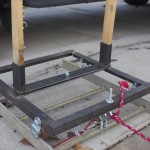
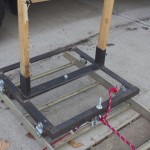
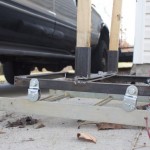
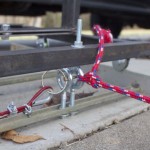
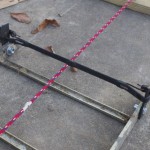
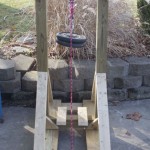
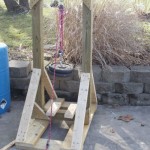

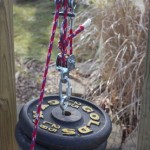
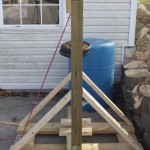
Leave a Reply